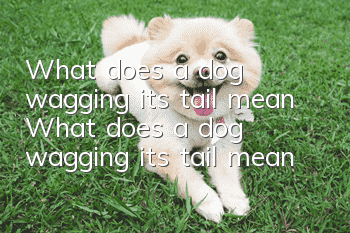What does a dog wagging its tail mean? What does a dog wagging its tail mean?

Tail wagging is social language
A dog wagging its tail is the same concept as when people greet each other. The body language of wagging the tail is how dogs greet each other, but there is a lot of meaning behind the wagging tail. A dog wagging its tail can represent happiness, friendliness, goodwill, or recognition. But it can also represent curiosity, concern, vigilance, insecurity, fear, and even threats. So don’t see a dog wagging its tail, just put a friendly tag on it and approach it excitedly.
Tail wagging represents emotional conflict
When an animal is in a conflicting state, it will feel pulled in two different directions at the same time, such as forward and backward, left and right. Because the two ideas conflict with each other, the animal stays where it is. But due to psychological tension, her body or a part of her body will obey one of the desires and start moving in a certain direction, but then stop and move in the opposite direction. This leads to a series of specific visual signals in the body language of different species, such as giraffes swinging their long necks, orangutans walking back and forth, sea otters flapping their tails, and dogs wagging their tails with us.
The emotions represented by the tail position
The position of the dog’s tail represents the different emotions of the dog at the moment. The height of the tail is in the middle, which means the dog is more relaxed. The tail is held completely flat, indicating that the dog is focused and even alert. The tail is high and upright, which represents threats, warnings and persuasion. A low tail position represents docility, worry, or physical discomfort. The tail between the legs represents fear, surrender, and praying not to be harmed. Random articles
- What do dogs eat to protect their stomach? It is important to protect their stomach and treat gastrointestinal diseases in dogs.
- How to tell if your dog is fat? Is your dog overweight?
- Will your dog catch a cold if you blow the air conditioner? What should you do if your dog catches a cold if you blow the air conditioner?
- What should you pay attention to when your dog drinks water? Don’t be careless when it comes to your dog’s drinking water.
- The dog's mouth bites and shakes. Why does the dog's mouth occasionally shake and bite?
- How to cut a dog's hair? Do you know how to cut a dog's hair correctly?
- Can dogs eat raw eggs? Why can’t dogs eat egg whites?
- Common Dog Problems in Summer How to Deal with Different Dog Problems
- How to keep dogs away from skin diseases. If you do this, will you see if your dog will still be infected with skin diseases?
- What causes anorexia in dogs? Dogs will become anorexic due to lack of exercise. Hounds run at least 5KM every day.



